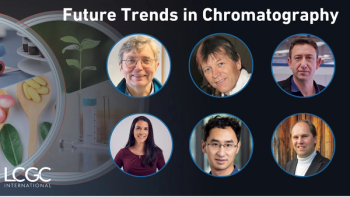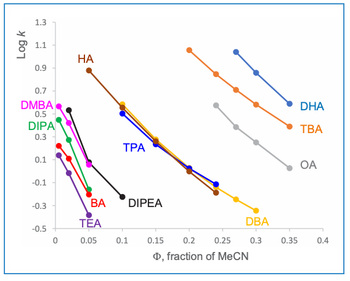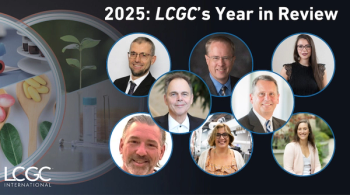Key Points:
- Method development in LC remains a complex, expertise-heavy process, but emerging AI tools offer new promise for managing interdependent parameters and accelerating optimization—especially in demanding formats like 2D LC.
- Data science techniques, including machine learning and surrogate optimization, are enabling faster, more flexible method development in complex analytical setups like SFE–SFC by reducing experimental burden and enhancing predictive power.
- Reliable ex vivo tissue metabolomics requires careful control of both pre- and post-analytical variables, with high-resolution mass spectrometry and dual chromatography systems offering new potential for clinical integration.
- QSERR models using both achiral and chiral molecular descriptors can successfully predict enantioselective behavior on polysaccharide-based CSPs, improving rational design of chiral separation methods.
- A hybrid AI-driven HPLC system that uses digital twins and mechanistic modeling can autonomously optimize methods with minimal experimentation.
- Global retention models based on serially coupled columns can accurately predict retention shifts in complex stationary phase combinations, offering a valuable tool for optimizing HPLC separations under varied elution conditions.
A stimulating session on method development in the age of artificial intelligence (AI) and machine learning (ML) was one of the highlights of the morning sessions on Tuesday, June 17, 2025, Day 2 of HPLC 2025.
Peter Schoenmakers from the University of Amsterdam/Centre for Analytical Sciences Amsterdam, Netherlands, kicked off the session with a talk entitled: A New Generation of LC Method Development Tools. Schoenmakers addressed the complexity of method development in liquid chromatography (LC), identifying it as a significant challenge in separation science. Each unique sample typically requires a tailored method, and sub-optimal approaches are undesirable due to the high costs associated with analysis time, instrumentation, and consumables, according to Schoenmakers. Method development is particularly intricate because numerous interdependent parameters influence the outcome, and current retention prediction capabilities are insufficient to differentiate between overlapping and resolved peaks reliably. He highlighted that the complexity intensifies in two-dimensional LC (LC×LC), where optimizing a method can span several months. This has driven a demand for computer-assisted tools that incorporate theoretical models and limited empirical data. Despite gradual progress over the past four decades, substantial expertise is still essential. The lecture explored whether recent advancements in AI have the potential to transform method development in LC and highlighted emerging developments and ongoing challenges in this space.
This was followed by a talk from Kevin Schug from the University of Texas at Arlington, Texas, USA, called: Data Science Tools for Advanced Method Development and Prediction in Analytical Measurements. Schug began his talk by stressing that data-driven approaches are transforming analytical method development, particularly in the face of growing complexity in chemical measurements. Traditional optimization processes can be time-consuming due to the large number of variables involved. Schug showcased the application of machine learning and surrogate optimization techniques, specifically within the context of online supercritical fluid extraction–supercritical fluid chromatography (SFE–SFC). These methods help streamline the optimization process by requiring fewer experimental steps, while accommodating more variables than conventional design strategies. One innovative technique he described involved encoding chemical structures through molecular feature generation based on atom connectivity, enhancing predictive capabilities for properties such as vacuum ultraviolet absorption. This method is currently being explored for its applicability in SFE–SFC. He concluded by emphasizing that composite performance objectives and data science methodologies are reshaping the field of analytical measurement.
The next talk was by Gunda Koellensperger from the University of Vienna in Austria, called: Delving into Tissue Metabolomics. Koellensperger has been investigating methodological challenges and innovations associated with ex vivo tissue metabolomics in clinical research. Her presentation focused on both pre-analytical and post-analytical variables that can influence the reliability of metabolomic findings. Given the heterogeneity of tissue samples and the limitations of homogenate-level analysis, careful consideration must be given to sampling strategies and experimental design, according to Koellensperger. Her talk highlighted recent advances in high-resolution mass spectrometry, including high-throughput dual chromatography systems and techniques that enable both broad-spectrum quantification and untargeted metabolite discovery. These developments also consider workflow miniaturization. She concluded by describing case studies, illustrating how ex vivo metabolomics using mass spectrometry is being integrated into cutting-edge clinical diagnostics and imaging approaches, where it serves as a benchmark method.
This presentation was followed by Debby Mangelings from Vrije Universiteit Brussel, Belgium, on Predicting Chiral Separations Using QSERR Models on Polysaccharide-Based Phases. Mangelings presented a study focused on improving the prediction of enantiomer retention on polysaccharide-based chiral stationary phases (CSPs) using quantitative structure enantioselective retention relationship (QSERR) models. Given that many pharmaceuticals are chiral and enantiopurity is crucial, reliable separation methods are essential. A data set of 48 diverse chiral compounds was analyzed on six CSPs using two mobile phases. Stepwise multiple linear regression (sMLR) models were built using achiral and chiral molecular descriptors—the latter derived from molecular dynamics simulations. Achiral descriptors successfully modeled overall retention, while chiral descriptors enabled accurate prediction of enantioselectivity, elution order, and separation. The integration of both models allowed estimation of individual enantiomer retention, marking a notable advancement in predicting chiral separations using linear models across varied pharmaceutical structures, concluded Mangelings.
AI-Driven HPLC Method Development with a Smart Digital Twin was presented by Fanyi Duanmu from University College London, UK. Duanmu introduced a novel, autonomous system for high performance liquid chromatography (HPLC) method development that integrates artificial intelligence and mechanistic modeling. Their “Smart HPLC Robot” predicts retention factors based on solute structures—via SMILES and molecular descriptors, without requiring new experiments at the outset. After a short experimental phase to calibrate the system, a digital twin takes over method optimization, adjusting variables such as flow rate and gradient to meet set goals. If mechanistic models lose accuracy, machine learning algorithms trained on prior data continue optimization. This hybrid system minimizes manual work, material use, and experimental time, offering a scalable and efficient solution for both analytical and preparative chromatography, according to Duanmu.
José-Ramón Torres-Lapasió from the University of Valencia, Spain, presented a talk entitled Global Models in Serially Coupled Column HPLC Development. Torres-Lapasió discussed the use of global retention models to improve method development in reversed-phase HPLC, particularly using serially coupled columns. The approach involved modeling retention using the Neue-Kuss equation for solutes separated across C18, phenyl, and cyano phases, alone and in combination. By evaluating chromatographic behavior under both isocratic and gradient elution, the study found that coupling columns caused notable retention shifts because of changing stationary phase environments. Global models proved reliable in predicting these shifts, especially under gradient conditions and for analytes with a broad polarity range. Torres-Lapasió concluded that findings suggest that global modeling is a powerful tool for optimizing separation strategies using hybrid column setups.





